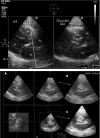Assessment of aortic stenosis by three-dimensional echocardiography: an accurate and novel approach
- PMID: 17488766
- PMCID: PMC1994466
- DOI: 10.1136/hrt.2006.110726
Assessment of aortic stenosis by three-dimensional echocardiography: an accurate and novel approach
Abstract
Background: Accurate assessment of aortic valve area (AVA) is important for clinical decision-making in patients with aortic valve stenosis (AS). The role of three-dimensional echocardiography (3D) in the quantitative assessment of AS has not been evaluated so far.
Objectives: To evaluate the reproducibility and accuracy of real-time three-dimensional echocardiography (RT3D) and 3D-guided two-dimensional planimetry (3D/2D) for assessment of AS, and compare these results with those of standard echocardiography and cardiac catheterisation (Cath).
Methods: AVA was estimated by transthoracic echo-Doppler (TTE) and by direct planimetry using transoesophageal echocardiography (TEE) as well as RT3D and 3D/2D. 15 patients underwent assessment of AS by Cath.
Results: 33 patients with AS were studied (20 men, mean (SD) age 70 (14) years). Bland-Altman analysis showed good agreement and small absolute differences in AVA between all planimetric methods (RT3D vs 3D/2D: -0.01 (0.15) cm(2); 3D/2D vs TEE: 0.05 (0.22) cm(2); RT3D vs TEE: 0.06 (0.26) cm(2)). The agreement between AVA assessment by 2D-TTE and planimetry was -0.01 (0.20) cm(2) for 3D/2D; 0.00 (0.15) cm(2) for RT3D; and -0.05 (0.30) cm(2) for TEE. Correlation coefficient r for AVA assessment between each of 3D/2D, RT3D, TEE planimetry and Cath was 0.81, 0.86 and 0.71, respectively. The intraobserver variability was similar for all methods, but interobserver variability was better for 3D techniques than for TEE (p<0.05).
Conclusions: The 3D echo methods for planimetry of the AVA showed good agreement with the standard TEE technique and flow-derived methods. Compared with AV planimetry by TEE, both 3D methods were at least as good as TEE and had better reproducibility. 3D aortic valve planimetry is a novel non-invasive technique, which provides an accurate and reliable quantitative assessment of AS.
Conflict of interest statement
Competing interests: None declared.
Similar articles
-
Comparison of left ventricular outflow geometry and aortic valve area in patients with aortic stenosis by 2-dimensional versus 3-dimensional echocardiography.Am J Cardiol. 2012 Jun 1;109(11):1626-31. doi: 10.1016/j.amjcard.2012.01.391. Epub 2012 Mar 20. Am J Cardiol. 2012. PMID: 22440128
-
Comparison of accuracy of aortic valve area assessment in aortic stenosis by real time three-dimensional echocardiography in biplane mode versus two-dimensional transthoracic and transesophageal echocardiography.Echocardiography. 2007 Nov;24(10):1065-72. doi: 10.1111/j.1540-8175.2007.00526.x. Echocardiography. 2007. PMID: 18001360
-
Comparison of two-dimensional and real-time three-dimensional transesophageal echocardiography in the assessment of aortic valve area.J Cardiol. 2012 May;59(3):337-43. doi: 10.1016/j.jjcc.2012.01.011. Epub 2012 Mar 7. J Cardiol. 2012. PMID: 22402417
-
Quantitative Analysis of Aortic Valve Stenosis and Aortic Root Dimensions by Three-Dimensional Echocardiography in Patients Scheduled for Transcutaneous Aortic Valve Implantation.Curr Cardiovasc Imaging Rep. 2014;7:9296. doi: 10.1007/s12410-014-9296-7. Curr Cardiovasc Imaging Rep. 2014. PMID: 25506408 Free PMC article. Review.
-
Cardiovascular magnetic resonance as a complementary method to transthoracic echocardiography for aortic valve area estimation in patients with aortic stenosis: A systematic review and meta-analysis.Hellenic J Cardiol. 2021 Mar-Apr;62(2):107-111. doi: 10.1016/j.hjc.2020.05.008. Epub 2020 Jun 11. Hellenic J Cardiol. 2021. PMID: 32535246
Cited by
-
Association between coronary flow and aortic stenosis during transcatheter aortic valve implantation.ESC Heart Fail. 2023 Jun;10(3):2031-2041. doi: 10.1002/ehf2.14316. Epub 2023 Apr 13. ESC Heart Fail. 2023. PMID: 37057311 Free PMC article.
-
Assessment of mitral bioprostheses using cardiovascular magnetic resonance.J Cardiovasc Magn Reson. 2010 Jun 23;12(1):36. doi: 10.1186/1532-429X-12-36. J Cardiovasc Magn Reson. 2010. PMID: 20573227 Free PMC article.
-
3D Echocardiography for Rheumatic Heart Disease Analysis: Ready for Prime Time.Front Cardiovasc Med. 2021 Jul 20;8:676938. doi: 10.3389/fcvm.2021.676938. eCollection 2021. Front Cardiovasc Med. 2021. PMID: 34355026 Free PMC article. Review.
-
Recent advances in echocardiography for valvular heart disease.F1000Res. 2015 Sep 28;4(F1000 Faculty Rev):914. doi: 10.12688/f1000research.6446.1. eCollection 2015. F1000Res. 2015. PMID: 26594349 Free PMC article. Review.
-
Cardiac imaging in valvular heart disease.Br J Radiol. 2011 Dec;84 Spec No 3(Spec Iss 3):S245-57. doi: 10.1259/bjr/54030257. Br J Radiol. 2011. PMID: 22723532 Free PMC article. Review.
References
-
- Selzer A. Changing aspects of the natural history of valvular aortic stenosis. N Engl J Med 198731791–98. - PubMed
-
- Bonow R O, Carabello B, Chatterjee K.et al ACC/AHA/ESC 2006 practice guidelines for the management of patients with valvular heart disease: executive summary. A Report of the American College of Cardiology/American Heart Association Task Force on Practice Guidelines (writing committee to revise the 1998 guidelines for the management of patients with valvular heart disease) developed in collaboration with the Society of Cardiovascular Anesthesiologists endorsed by the Society for Cardiovascular Angiography and Interventions and the Society of Thoracic Surgeons. J Am Coll Cardiol 200648598–675. - PubMed
-
- Gorlin R, Gorlin S. Hydraulic formula for calculation of the area of the stenotic mitral valve, other cardiac valves, and central circulatory shunts. Am Heart J 1951411–18. - PubMed
-
- Skjaerpe T, Hegrenaes L, Hatle L. Non‐invasive estimation of valve area in patients with aortic stenosis by Doppler ultrasound and two‐dimensional echocardiography. Circulation 198572810–818. - PubMed
Publication types
MeSH terms
LinkOut - more resources
Full Text Sources
Research Materials




